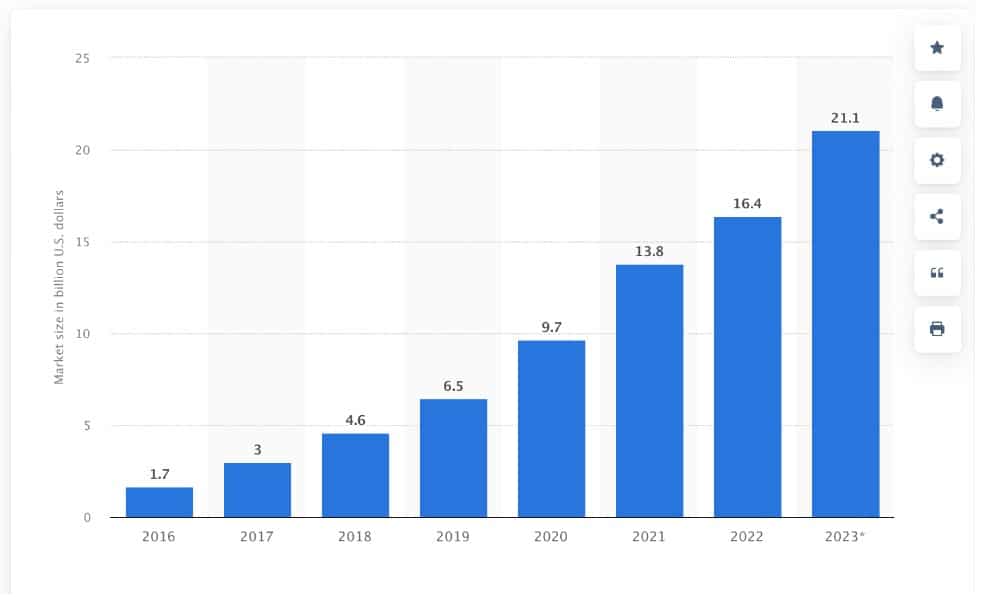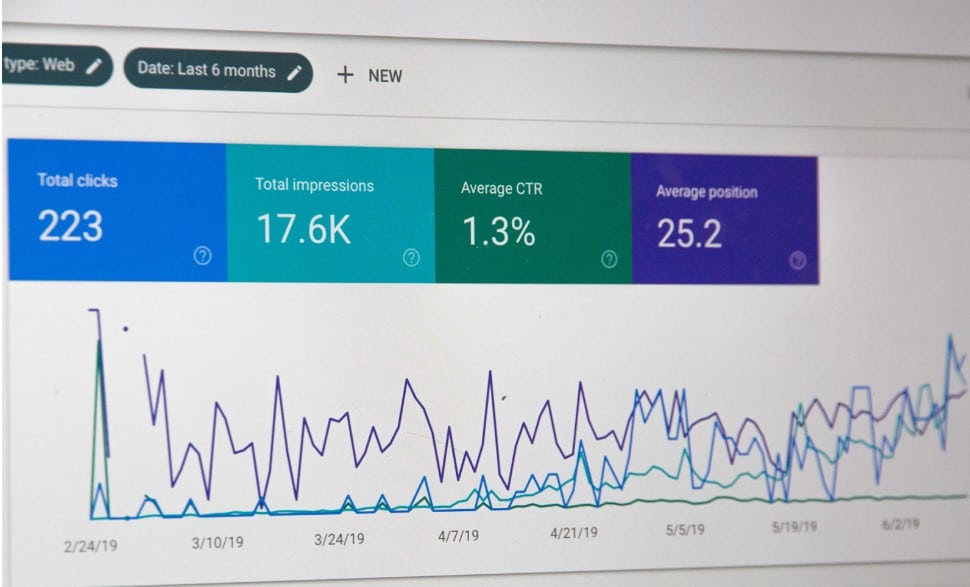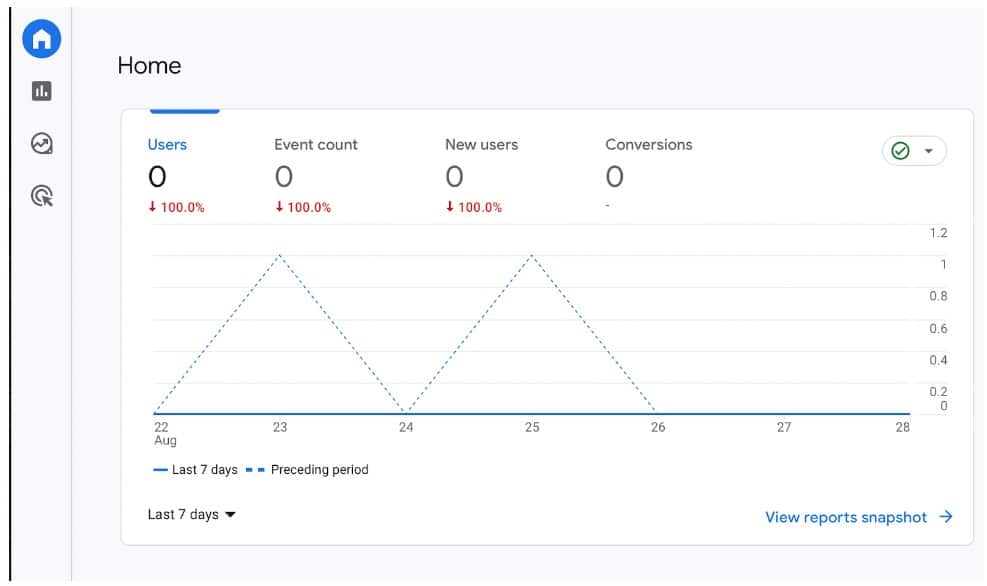As brands seek to stand out from competitors and offer audiences targeted content, many are turning to social media marketing for support. In particular, influencer marketing is enjoying a popularity boom, alongside new technology like AI content marketing tools.
It’s estimated that the global value of influencer marketing is around 21 billion USD, and growing year on year.

Image sourced from Statistica
Influencer marketing is a form of digital and social marketing. Brands will typically work with an influencer in their industry to arrange paid product placements or endorsements to their audience.
Influencer marketing does what it says on the tin: content creators with a large and relevant following influencing their audience with the trust and industry knowledge they have built.
The keys to a successful influencer campaign
A successful influencer marketing campaign starts and ends with two factors: knowing your audience and choosing the perfect influencer.
Knowing your audience means knowing where they exist in online spaces, what they want from your brand, and what content they interact with the most. This feeds into selecting your influencer, as you will understand who your audience is following and what content engages them and drives conversion.
When choosing your marketing partner, it’s key that you think about more than their follower count. A large audience is fantastic, but only if that audience is relevant to your products. You will see a better ROI with a smaller, targeted audience than with a larger, less relevant following.
Benefits of influencer marketing
The major benefit of influencer marketing strategies is plain to see. The right influencer will put your product in front of relevant people who are likely to engage with your brand – and may make a purchase.
Marketing with social media influencers also helps to build long-term relationships in your industry and build brand awareness and trust. It is a potentially very high ROI strategy.
The other great thing about influencer marketing efforts is that they can be easily tracked. Using a CRM and social media management platform, it’s possible to easily perform data quality checks and ensure that you’re receiving high quality leads and traffic from your campaigns.
To enhance the efficiency and organization of your influencer marketing endeavors, remember to organize receipts within your campaign management process.
How to track sales from influencer marketing efforts
That being said, influencer marketing only represents a high ROI if you monitor and analyze your campaigns. The best way to do this is to directly track conversions and sales to see whether you’re meeting your goals—which ought to be at the top of your influencer marketing checklist.

Here are some of the most popular and effective ways of tracking sales from influencer marketing efforts:
1. Affiliate links
One of the easiest ways to monitor and track sales from influencer marketing campaigns is to add influencers and partners to your affiliate program.
An affiliate program allows you to provide each influencer with a unique link called an affiliate link.
Different platforms and affiliate programs work in different ways. Some platforms will only generate links that are valid for 24 hours, while others are evergreen or functional over 4+ weeks.
Here are 3 ways to generate affiliate links and track your influencer marketing successes:
- Social landing pages: Certain platforms will generate unique, trackable links for you that can be shared by influencers with their audience.
- Platform-generated links: Some sales platforms (like Shopify) will generate affiliate links with tracking, in-platform.
- UTM parameters: A bit more technical but incredibly versatile, these affiliate links allow you to track evergreen activity by tagging individual influencers.
The variety of affiliate marketing links make this a versatile and simple way of tracking influencer marketing efforts.
The other piece of good news is that affiliate programs are easily managed, with the right equipment.

If you choose to implement cloud data management or a portal system for your influencers, you can easily access data from across your campaign, and perform ongoing data analysis. A cloud-based affiliate platform is one of the simplest and most effective ways to manage affiliate partners and influencers, even across large campaigns.
2. Promo codes
Similar to affiliate links, promo codes are unique to each influencer and allow you to see where a purchase has come from as it comes through to your business.
One of the major benefits of promo codes over affiliate links is that they are plain text, so they can be featured in Instagram captions and other areas of plain text content.
Instagram, for example, does not allow links in captions at all, and restricts links in stories. However, a promo code can be entered into any type of content, from stories to a video sticker, and copied by individual users.
You’ve probably seen promo codes for retail and ecommerce brands, but they can work for all sectors if used correctly. Here’s an example of how a promo code might work for a professional services brand.
Consider a financial services IT solutions company. Instead of offering promo codes (like discounts or multibuy offers) via an influencer, this company may raise brand awareness and offer value with promo codes on additional products or content.
For example, this brand might work with an IT and technology influencer to drive sales of a new ebook or other accompanying digital product.
Many influencers also use hybrid links, wherein an affiliate link enables each customer to redeem a promo code.
3. Referral traffic
If your brand uses Google analytics or other traffic measurements, then you can track referrals and subsequent activity to your site.

In Google Analytics, you’ll find referrals under the ‘Acquisition’ tab—categorized under ‘all traffic’. You can then track individual sessions using a heat mapping software like HotJar to understand user journeys and see which referral links are driving the most sales.
Why you need to track influencer marketing sales
You now understand how to track sales from influencer marketing efforts. But why do you need to do so?
Like any marketing strategy, influencer marketing needs to deliver a high ROI to be worth investing time and money into. While there’s no way of avoiding analytics and tracking your progress, there are plenty of tips and ways to make your life easier—like downloading a remote desktop management tool.
You could also consider using real user monitoring, which allows you to gain valuable insights into how actual users interact with your website or application, providing crucial data for optimizing your influencer marketing campaigns and ensuring a seamless user experience.
Here’s why you need to track your influencer marketing sales and the key points to look out for:
Compare influencer results
Most brands don’t just use one influencer. Some work with hundreds of affiliates and influencers—and not all influencers are created equal.
By comparing sales and engagement from across the board, you can see which of your influencers are working well for your brand and worth investing in further. Alternatively, you can identify which influencers might not be the best fit with your brand and avoid wasted resources.
Track engagement and activity
Of course, your end goal is to drive sales and grow your business, but this isn’t the only metric you need to be measuring across your influencer marketing efforts.
While engagement doesn’t always equal sales, it’s still an important metric for brand awareness and showing the true value of an individual influencer to your business.
For example, your brand may work with a variety of niche micro influencers and some larger accounts that aren’t as tightly related to your business. While your micro influencers might drive more sales, larger accounts—importantly, still relevant in some way to your industry—may achieve unrivaled levels of engagement that drive interest and awareness for your brand.
Identify areas of low ROI
Tracking your influencer marketing sales ultimately serves to identify areas of low ROI, ensuring that your brand is achieving its goals by effectively allocating its resources.
Monitoring sales and engagement across a large pool of influencers can seem like a daunting task, involving lots of data and complex business processes.
To do this, you might want to implement a data orchestration platform to streamline your work processes and make your tracking more efficient across the board.
Final thoughts
Influencer marketing can be a valuable tool in your winning marketing strategy, helping you to increase sales and drive brand awareness. To make it worthwhile, you need to track engagement sales to ensure that your strategy is actually achieving your goals.
This is simple to do with affiliate links, promo codes, and a well-maintained CRM. Using these simple tracking tools can show you areas of low and high ROI and ensure that your marketing resources are going to the right place – earning your brand higher sales, industry reputation and brand awareness.




